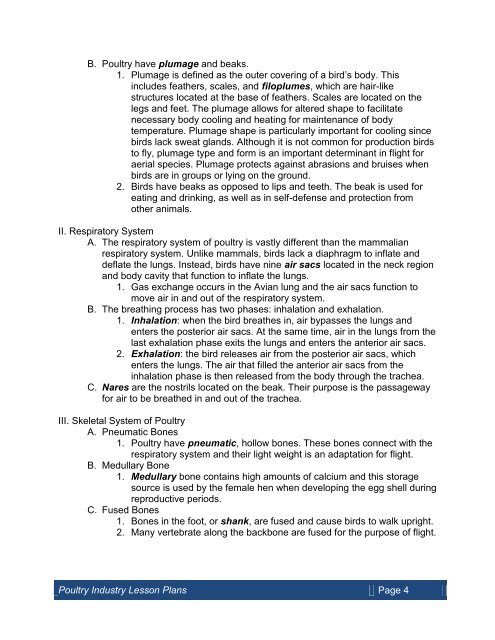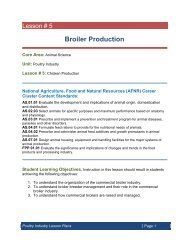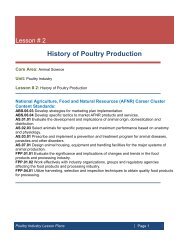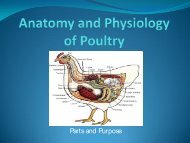Lesson Plan - U.S. Poultry and Egg Association
Lesson Plan - U.S. Poultry and Egg Association
Lesson Plan - U.S. Poultry and Egg Association
Create successful ePaper yourself
Turn your PDF publications into a flip-book with our unique Google optimized e-Paper software.
B. <strong>Poultry</strong> have plumage <strong>and</strong> beaks.<br />
1. Plumage is defined as the outer covering of a bird’s body. This<br />
includes feathers, scales, <strong>and</strong> filoplumes, which are hair-like<br />
structures located at the base of feathers. Scales are located on the<br />
legs <strong>and</strong> feet. The plumage allows for altered shape to facilitate<br />
necessary body cooling <strong>and</strong> heating for maintenance of body<br />
temperature. Plumage shape is particularly important for cooling since<br />
birds lack sweat gl<strong>and</strong>s. Although it is not common for production birds<br />
to fly, plumage type <strong>and</strong> form is an important determinant in flight for<br />
aerial species. Plumage protects against abrasions <strong>and</strong> bruises when<br />
birds are in groups or lying on the ground.<br />
2. Birds have beaks as opposed to lips <strong>and</strong> teeth. The beak is used for<br />
eating <strong>and</strong> drinking, as well as in self-defense <strong>and</strong> protection from<br />
other animals.<br />
II. Respiratory System<br />
A. The respiratory system of poultry is vastly different than the mammalian<br />
respiratory system. Unlike mammals, birds lack a diaphragm to inflate <strong>and</strong><br />
deflate the lungs. Instead, birds have nine air sacs located in the neck region<br />
<strong>and</strong> body cavity that function to inflate the lungs.<br />
1. Gas exchange occurs in the Avian lung <strong>and</strong> the air sacs function to<br />
move air in <strong>and</strong> out of the respiratory system.<br />
B. The breathing process has two phases: inhalation <strong>and</strong> exhalation.<br />
1. Inhalation: when the bird breathes in, air bypasses the lungs <strong>and</strong><br />
enters the posterior air sacs. At the same time, air in the lungs from the<br />
last exhalation phase exits the lungs <strong>and</strong> enters the anterior air sacs.<br />
2. Exhalation: the bird releases air from the posterior air sacs, which<br />
enters the lungs. The air that filled the anterior air sacs from the<br />
inhalation phase is then released from the body through the trachea.<br />
C. Nares are the nostrils located on the beak. Their purpose is the passageway<br />
for air to be breathed in <strong>and</strong> out of the trachea.<br />
III. Skeletal System of <strong>Poultry</strong><br />
A. Pneumatic Bones<br />
1. <strong>Poultry</strong> have pneumatic, hollow bones. These bones connect with the<br />
respiratory system <strong>and</strong> their light weight is an adaptation for flight.<br />
B. Medullary Bone<br />
1. Medullary bone contains high amounts of calcium <strong>and</strong> this storage<br />
source is used by the female hen when developing the egg shell during<br />
reproductive periods.<br />
C. Fused Bones<br />
1. Bones in the foot, or shank, are fused <strong>and</strong> cause birds to walk upright.<br />
2. Many vertebrate along the backbone are fused for the purpose of flight.<br />
<strong>Poultry</strong> Industry <strong>Lesson</strong> <strong>Plan</strong>s Page 4








